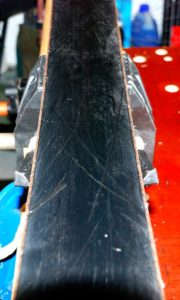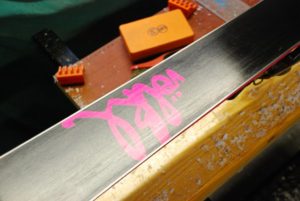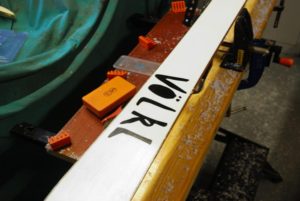 Rachel dropped off two sets of skis, bravely volunteering her own K2s for a lesson while her other half’s Heads joined the queue with the others. Both sets had a few gouges on the base so we extended the lesson to cover prepping, filling & scraping the gouges.
Rachel dropped off two sets of skis, bravely volunteering her own K2s for a lesson while her other half’s Heads joined the queue with the others. Both sets had a few gouges on the base so we extended the lesson to cover prepping, filling & scraping the gouges.
First though the bases weren’t perfectly flat so they got a quick once over with the base planer. Once the bases were flat, gouges filled and scraped level and the bases restructured it was finally time to set the base bevels. The edges were pretty rusty and dinged (“I’ve had a lot of fun making that big a mess of my edges”) but they were happy to succumb to a few passes with the file guide. The side edges, on the other hand, put up plenty of resistance with the first edge refusing to play ball. Although the sidewall was conscientiously planed away the 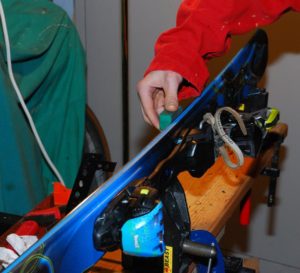 panzar file zinged away making that distinctive, high pitched riding on plastic noise regardless of what we tried. Eventually it was beaten by inhuman amounts of filing with a 200 grit diamond file. Naturally the next three edges all behaved themselves impeccably. Despite the beaten look of the steel they took a nice edge – here’s Rachel just putting the icing on the cake with the gummi.
panzar file zinged away making that distinctive, high pitched riding on plastic noise regardless of what we tried. Eventually it was beaten by inhuman amounts of filing with a 200 grit diamond file. Naturally the next three edges all behaved themselves impeccably. Despite the beaten look of the steel they took a nice edge – here’s Rachel just putting the icing on the cake with the gummi.
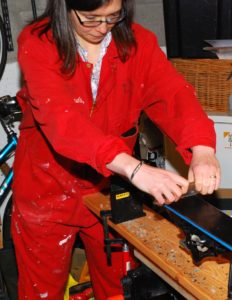 The extra time used on base planing, gouge filling & filing the cussed edge meant that we were keen to get the waxing sorted quickly. Fortunately Rachel proved to be a world-class wax scraper, and despite protestations that she never irons she was a dab hand at that too. It could be argued that we didn’t spend the prescribed amount of time waiting on wax for either base or top coat but by now the combined stomach rumbling sounded like the Harley Owner’s Club firing up for a quick blat to Flora’s café so we pressed on.
The extra time used on base planing, gouge filling & filing the cussed edge meant that we were keen to get the waxing sorted quickly. Fortunately Rachel proved to be a world-class wax scraper, and despite protestations that she never irons she was a dab hand at that too. It could be argued that we didn’t spend the prescribed amount of time waiting on wax for either base or top coat but by now the combined stomach rumbling sounded like the Harley Owner’s Club firing up for a quick blat to Flora’s café so we pressed on.
The final result was worth the suffering and the K2s were at least as gorgeous as the Heads. Here’s to a great holiday in Morzine.
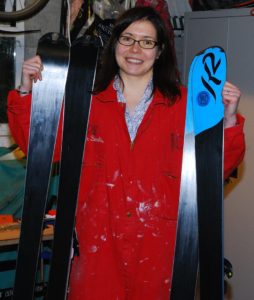

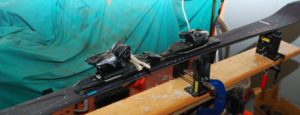

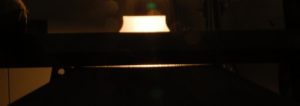
 Usual edge & wax job and here they are all shiny and ready to go again. Just watch out for hungry pandas on the slopes.
Usual edge & wax job and here they are all shiny and ready to go again. Just watch out for hungry pandas on the slopes.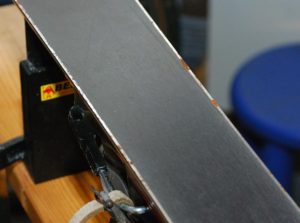
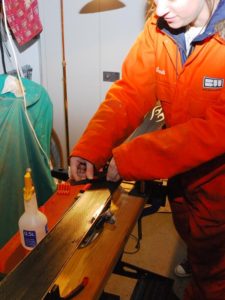 Base edges are one degree and they needed little more than a few swipes to get all the Sharpie ink (and rust) off and settled into their old glory. Linda is using the 200 grit diamond file in the photo which is just long enough for the base file guide and needs careful finger support to keep it all together. Diamond file enthusiasts will note the spray bottle of highly specialised diamond file cutting fluid (Aberdeen tap water) on the bench.
Base edges are one degree and they needed little more than a few swipes to get all the Sharpie ink (and rust) off and settled into their old glory. Linda is using the 200 grit diamond file in the photo which is just long enough for the base file guide and needs careful finger support to keep it all together. Diamond file enthusiasts will note the spray bottle of highly specialised diamond file cutting fluid (Aberdeen tap water) on the bench.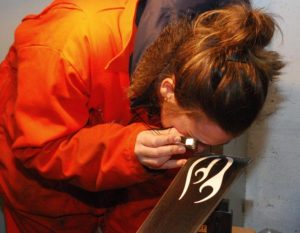 A key part of learning to tune your own gear is to involve all your senses in the job. Fingers are great at feeling inconsistencies that you might not see; files running on plastic sidewall instead of steel edge make a high-pitched whizz and nothing really beats the 10x hand lens for getting to see exactly what’s going on. Lots of people struggle with hand lenses but Linda got the style straight away – hold it close to your eye and move your head close to the area of interest. Sadly all she got to see here was rusty pits on the inside of her edges but no matter – she’s around the curve of the tip so we don’t really care other than for aesthetics.
A key part of learning to tune your own gear is to involve all your senses in the job. Fingers are great at feeling inconsistencies that you might not see; files running on plastic sidewall instead of steel edge make a high-pitched whizz and nothing really beats the 10x hand lens for getting to see exactly what’s going on. Lots of people struggle with hand lenses but Linda got the style straight away – hold it close to your eye and move your head close to the area of interest. Sadly all she got to see here was rusty pits on the inside of her edges but no matter – she’s around the curve of the tip so we don’t really care other than for aesthetics.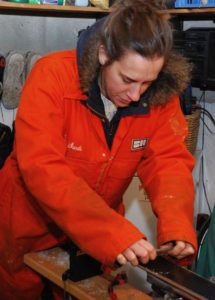
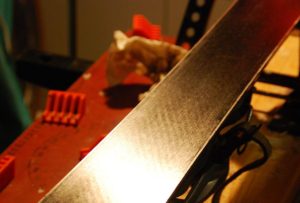
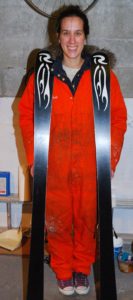
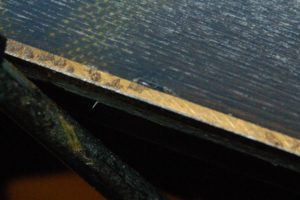
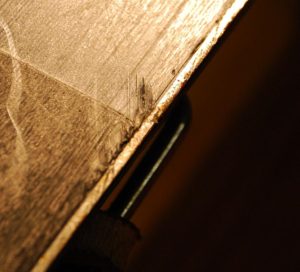
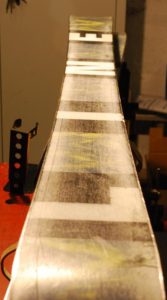

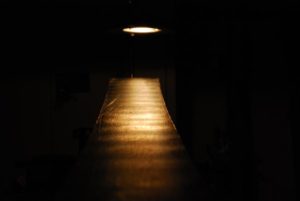

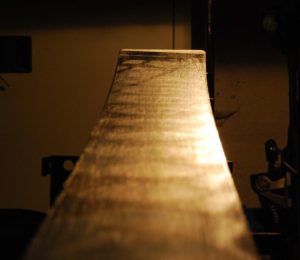
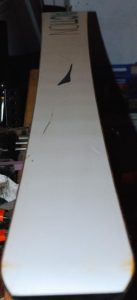 Another concern was the huge hole shot that had been repaired some time ago with a big swoosh of black P-tex. Although it has held on for quite some time it is about half a millimetre shy of the base so it will act as a little anchor. After much furious base planing it was still keeping its head down so I roughened up the surface with a stiff brush and added more black P-tex to bring it up flush with the base. Once that was done and the other gouges repaired with clear & colourless P-tex (rather disconcertingly you can still see the original gouge even after a perfect repair) it was time to edge the skis. Faction ask for 1 degree base and 1.5 degree side, just to be awkward, but someone else had tuned the sides to 1 degree so I followed their lead. The edges came up very nicely which was a pleasant change from the Bacons.
Another concern was the huge hole shot that had been repaired some time ago with a big swoosh of black P-tex. Although it has held on for quite some time it is about half a millimetre shy of the base so it will act as a little anchor. After much furious base planing it was still keeping its head down so I roughened up the surface with a stiff brush and added more black P-tex to bring it up flush with the base. Once that was done and the other gouges repaired with clear & colourless P-tex (rather disconcertingly you can still see the original gouge even after a perfect repair) it was time to edge the skis. Faction ask for 1 degree base and 1.5 degree side, just to be awkward, but someone else had tuned the sides to 1 degree so I followed their lead. The edges came up very nicely which was a pleasant change from the Bacons.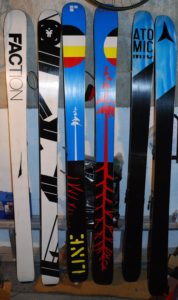
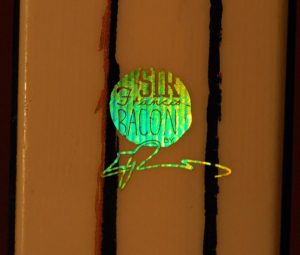 John brought round a range of skis. As well as the
John brought round a range of skis. As well as the 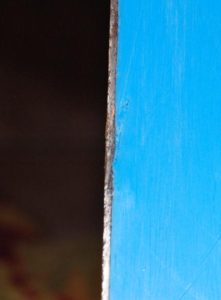 During the routine check a small bulge on the base turned out to be a bit
During the routine check a small bulge on the base turned out to be a bit It’s hard to see on this photo but the P-tex is very slightly coming away from the edge for an inch in each direction and a thin strip of rust is peeping out.
It’s hard to see on this photo but the P-tex is very slightly coming away from the edge for an inch in each direction and a thin strip of rust is peeping out.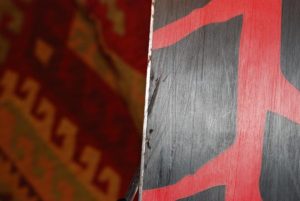 The edges are horrible but John has been careful to keep a left & right ski so the less-used edges can be saved, to an extent anyway. Obviously there are other gouges, one of which seems to have a bit of quartz wedged in it – a wee memento from a past trip.
The edges are horrible but John has been careful to keep a left & right ski so the less-used edges can be saved, to an extent anyway. Obviously there are other gouges, one of which seems to have a bit of quartz wedged in it – a wee memento from a past trip.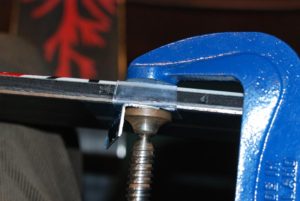
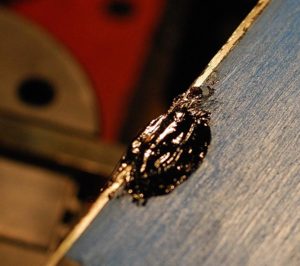 The hole I made around the break has a fair bit of Araldite lining it but there is plenty of steel exposed so out with the metal-grip and the gas-fired base mender soldering iron. Metal-grip is basically P-tex with added kryptonite so it sticks properly to steel. Once the Metal-grip is smoothed and the other remaining gouges are filled & scraped it is time to veeeeery carefully file down the highs around the repair.
The hole I made around the break has a fair bit of Araldite lining it but there is plenty of steel exposed so out with the metal-grip and the gas-fired base mender soldering iron. Metal-grip is basically P-tex with added kryptonite so it sticks properly to steel. Once the Metal-grip is smoothed and the other remaining gouges are filled & scraped it is time to veeeeery carefully file down the highs around the repair.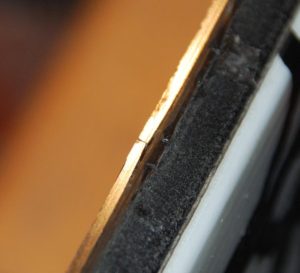 This photo makes the edge look proud of the base but in fact it isn’t – the edge sinks away slightly so I took a further photo to try to show the repair in a better light.
This photo makes the edge look proud of the base but in fact it isn’t – the edge sinks away slightly so I took a further photo to try to show the repair in a better light.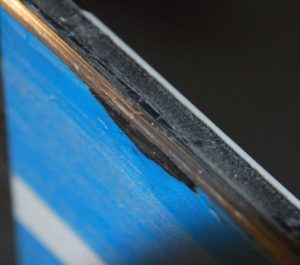
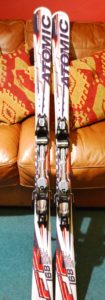 I’ll admit that I like Atomic skis a lot. They are one of the few ski manufacturers that unashamedly ship skis with 1 degree base & 3 degree side bevels – the golden ratio according to many of the
I’ll admit that I like Atomic skis a lot. They are one of the few ski manufacturers that unashamedly ship skis with 1 degree base & 3 degree side bevels – the golden ratio according to many of the 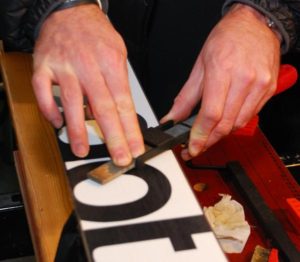 Next step as always is to double check the base bevels with a sharpie and file in the appropriate base file guide. They were already at 1 degree as per manufacturer’s guidance so they were just given a few swipes to clear rust and a couple of minor scratches.
Next step as always is to double check the base bevels with a sharpie and file in the appropriate base file guide. They were already at 1 degree as per manufacturer’s guidance so they were just given a few swipes to clear rust and a couple of minor scratches.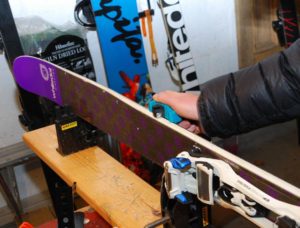 Before we could do any edging the sidewalls needed planing. Although the skis had been tuned once before there was a good bit of plastic in the way of the edging tools. As always getting the right combination of weight & speed to plane the sidewall perfectly smooth takes plenty of time & patience, especially as these walls had been left pretty lumpy by the last guy. If in doubt many fast & light strokes always beat one huge heroic effort. And finally, don’t be frightened to use a knife to remove big lumps if the alternative is shattering your planer blade.
Before we could do any edging the sidewalls needed planing. Although the skis had been tuned once before there was a good bit of plastic in the way of the edging tools. As always getting the right combination of weight & speed to plane the sidewall perfectly smooth takes plenty of time & patience, especially as these walls had been left pretty lumpy by the last guy. If in doubt many fast & light strokes always beat one huge heroic effort. And finally, don’t be frightened to use a knife to remove big lumps if the alternative is shattering your planer blade.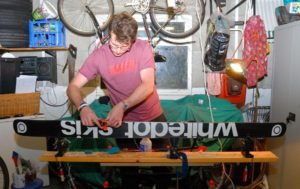
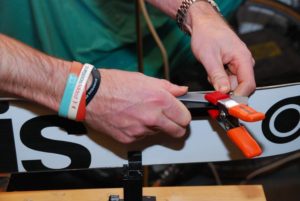
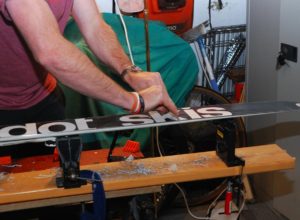 John tried out a few angles with the wax scraper, including this one pictured left. As always touring skis are a drag to scrape just because they are so big.
John tried out a few angles with the wax scraper, including this one pictured left. As always touring skis are a drag to scrape just because they are so big.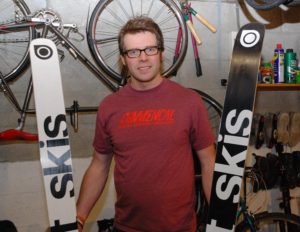 The scraping showed up the weird M-shaped bases again but some furious brushing left them in tip top condition. Here’s John showing off his planks and just ready to head back home and dig out a few more sets of skis for the treatment.
The scraping showed up the weird M-shaped bases again but some furious brushing left them in tip top condition. Here’s John showing off his planks and just ready to head back home and dig out a few more sets of skis for the treatment. Her LINE skis are needed for a trip to the Alps on Friday so she brought them round for some pre-trip TLC. They are a good looking ski, quite wide under the binding but not ironing-board wide like true powder skis. Pretty light too.
Her LINE skis are needed for a trip to the Alps on Friday so she brought them round for some pre-trip TLC. They are a good looking ski, quite wide under the binding but not ironing-board wide like true powder skis. Pretty light too.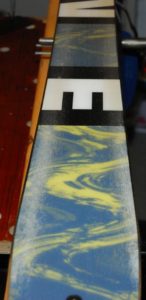 Serious white lines on the bases indicating not just “not much” wax left but frankly indicating “less than zero wax left”. To get this effect requires years of studious neglect. It’s not 100% percent certain that simply waxing them will bring them back to life once they have reached this state. When ski forum experts talk about “oxidized” bases this is what they mean. Any organic chemists out there care to comment on whether or not high molecular weight polyethylene gets “oxidized” rather than “scratched”?
Serious white lines on the bases indicating not just “not much” wax left but frankly indicating “less than zero wax left”. To get this effect requires years of studious neglect. It’s not 100% percent certain that simply waxing them will bring them back to life once they have reached this state. When ski forum experts talk about “oxidized” bases this is what they mean. Any organic chemists out there care to comment on whether or not high molecular weight polyethylene gets “oxidized” rather than “scratched”?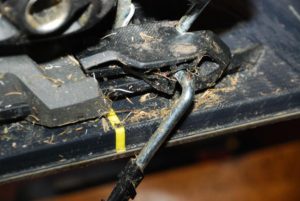 Another giveaway that the skis are more used to pastoral use is the amount of grass & soil in the bindings.
Another giveaway that the skis are more used to pastoral use is the amount of grass & soil in the bindings.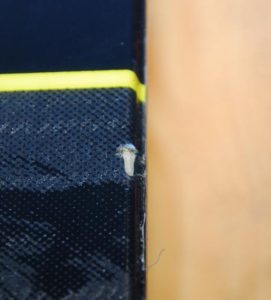
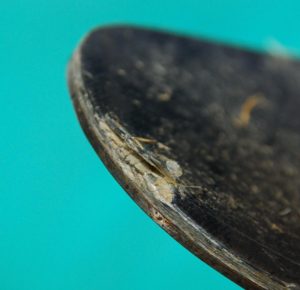
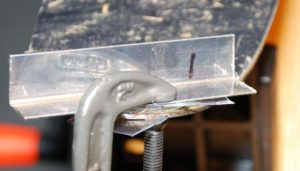
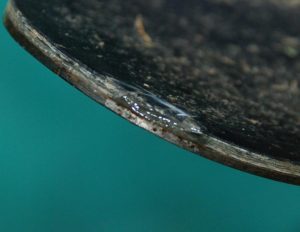
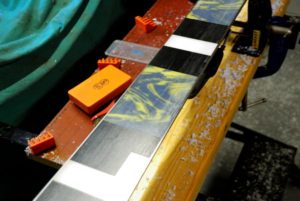 Nothing like as bad as they were, and I would hope that the two coats will keep Hazel gliding for a whole week in the Alps, but not quite perfect. Nothing for it but another visit to the ManCave after the Alps to freshen up the structure, check out the various nicks and wax them back up again. Of course the huge discount means the more work she gets done the more savings she’ll have for Jägerbombs or whatever young people drink on ski trips these days. Bon voyage!
Nothing like as bad as they were, and I would hope that the two coats will keep Hazel gliding for a whole week in the Alps, but not quite perfect. Nothing for it but another visit to the ManCave after the Alps to freshen up the structure, check out the various nicks and wax them back up again. Of course the huge discount means the more work she gets done the more savings she’ll have for Jägerbombs or whatever young people drink on ski trips these days. Bon voyage!